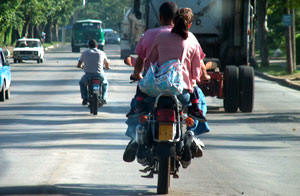
|
|
|
La Revista Joven más antigua de Cuba January 12, 2006 |
WITHOUT
PROTECTION? FORGET IT!
By Jorge Sariol
A CubaNews translation edited by Walter Lippmann.

A helmet is neither a charm nor a symbol of status.
After all, it makes no difference whether it is a futuristic model à la Darth Vader, a flamboyant device that looks like a pressure cooker, or even something that reminds us of a medieval dress hat or a rehashed condom.
Wearing it won’t prevent any accidents, but it helps protect your head if anything happens.
Granted, it makes you feel a little hot, it’s hard to get used to it at first and –above all– are rather expensive.
When speaking about it, experts use terms that seem to have been taken from one of Freud’s treaties, but their considerations are not to be taken lightly: they’re called “main passive safety element of motorcycle and motor-bicycle[1] drivers and passengers».
A fancy grammar construction with a first-world-like ring to it, but instructive nonetheless. In other words, wear it. Just like that. Otherwise a simple slip at a “corner” is likely to get you a broken skull.
According to experts in the field of traffic and road safety, “it is 28% effective in preventing death by traffic accidents, and it halves the likelihood of cranial injury. It has been proved to reduce the severity of cranial base contusions and the risk of cervical fracture or dislocation and spinal and brain injuries.
Surveys have it that between 2002 and late June, 2005 motorcycles ranked third in the list of incidences, though they account for “the most serious cases” with an average of more than one victim per accident.
It is expected that by January 2006 all those who ride motorcycles and motor-bicycles be compelled by legislation to wear a helmet, at least and for the time being in the case of the drivers, although article 81, item 1, of Law No. 60 in the Traffic and Roads Code establishes its mandatory use by anyone riding these vehicles, both state-owned and private, new or old.
Things are getting serious now. Failure to comply will entail the payment of a fine corresponding to the third group, according to the level of seriousness: an amount of ten pesos, taking into account whether the transgressor has accumulated six points in the permanent assessment of infractions.
Will the same requirements be applied to those who ride the incredible riquimbilis?[2] If they are deemed to be motor-bicycles instead of technological aberrations, of course. In my opinion, the riquimbilis are the topmost expression of Cuban ingenuity and deserve a monument to result-generating inventiveness in times of city transport crises, but these demands had to come a long way and incorporate many requirements, covering from fast braking times to environmental and sound pollution. Nowadays they have become a stain in the landscape, but their time will eventually come. Wearing the safety helmet is what counts right now.
[1] Bicycles provided with motors (T.N.).
[2] A bicycle to which an engine has been fitted (T.N.).
----- Original Message -----
http://www.almamater.cu/diversos/pag06/motos.htm
¿SIN PROTECCIÓN? ¡NI PENSARLO!
Por Jorge Sariol
El casco no es un amuleto ni un símbolo del status.
A fin de cuentas da igual si el modelo es futurista, onda Darth Vader, o aparatoso con forma de olla de presión; si recuerda a un morrión medieval o es del tipo condón recapado.
Llevarlo puesto no va a evitar los accidentes, pero ayuda a protegerte la cabeza siocurre una eventualidad.
Es cierto que da un poco de calor, cuesta trabajo acostumbrarse al principio y —sobre todo— son uncaros.
Los especialistas hablan de él con léxico sacado de un tratado de Freud, pero las consideraciones no soncosas de tomar a broma: son llamados «principal elemento de seguridad pasiva de conductores pasajeros de motos y ciclomotores».
Suena elegante y con onda primermundista la construcción gramatical, pero igual es aleccionadora. Es decir, úsalo, sin más ni más, si no probablemente con un simple resbalón «esquinero» te rompas el cráneo.
Según afirman los expertos en el tema del tránsito y la seguridad vial,«su eficacia en la prevención de muertes por accidentes es de 28 por ciento, y reduce a la mitad las probabilidades de sufrir lesiones craneales. Se ha comprobadoque reduce la gravedad de las contusiones en la base del cráneo, y rebaja los riesgos de fracturas y luxaciones cervicales, traumatismos espinales y encefálicos.
Las encuestas afirman que desde el 2002 hasta el cierre de junio 2005, las motos van en tercer lugar en las incidencias y «aportan las consecuencias más graves», con más de una víctima por accidentes como promedio.
Se espera que para enero del 2006 ya será obligatorio (establecido por ley) que todos los que van en motos y ciclomotores lo lleven, al menos y por ahora los que van conduciendo aunque la Ley 60, Código de Vialidad y Tránsito, inciso 1, del artículo 81, establece que debe ser llevado por todo el que se monte en uno de estos, sean estatales o privados, nuevos o viejos.
Ahora la cosa va en serio. A quien no cumpla le tocará la multa correspondiente al tercer grupo, considerando su peligrosidad: con cuantía ascendente a diez pesos según y acumulara unos seis puntosen la evaluación permanente de infracciones.
¿Tendrían las
mismas exigencias con losque andan a lomo de los increíbles riquimbilis? (1). Si
son considerados como ciclomotores y no como aberraciones de la tecnología,
indudablemente. A mi modo de ver los riquimbilis son la máxima expresión del
ingenio criollo y merecen un obelisco a la inventiva generadora de resultados en
tiempo decrisis del transporte urbano, pero las exigencias tuvieron que irpor un
largo camino de requerimientos, desde una respuesta rápida al frenado, hasta la
contaminación ambiental y sonora. Hoy son líos en el paisaje. Ya les tocará su
parte. La cuestión por ahora es el uso del casco protector.
(1) Bicicletas a las que se les ha adaptado un motor